














May 7, 2024


EMERGENCY APREPAREDNESS: WERESPONSIBILITY ALL SHARE

Important things to remember during an earthquake
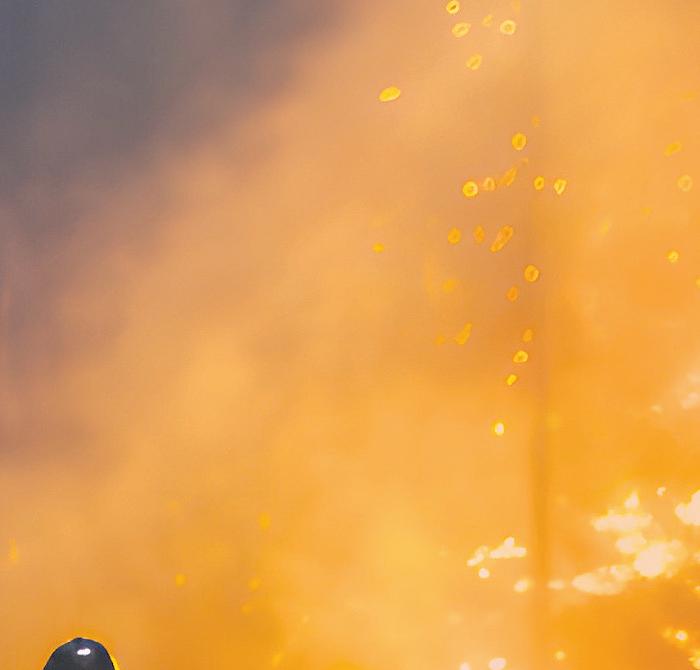

Local Emergency Program Contact Home And Shelter-In-Place Kit
Grab & Go Bags



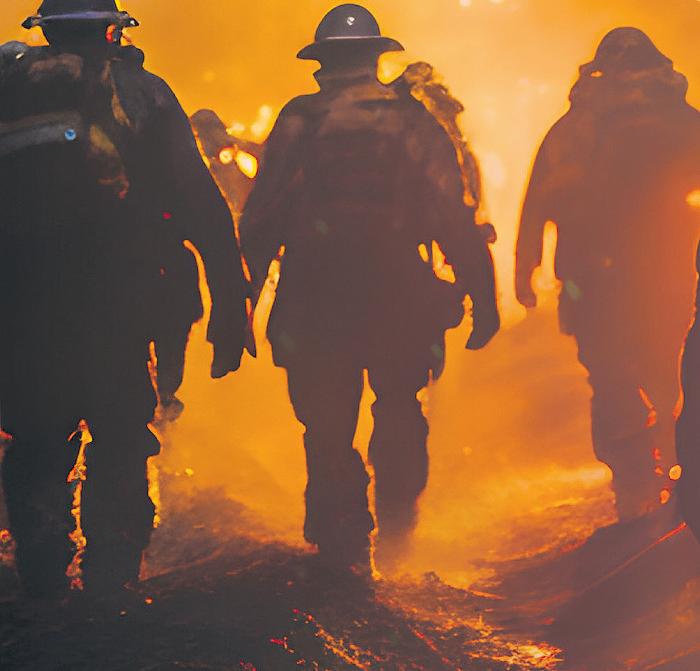

























Recently, B.C. has coped with a continuing pandemic, a record-breaking heat dome and a devastating atmospheric river event. These emergencies were felt across the province and are having lasting effects on those still recovering. As we look ahead, we know that a changing climate is causing more frequent and destructive weather events. Everyone has a role in emergency preparedness and now is the time to ensure you’re prepared.
British Columbia is working on an all-ofsociety approach to disaster risk reduction. That means everyone, in every organization, including individual citizens has a role to play in emergency preparation, response and recovery. Together, we can plan ahead, improve our response to these events and recover with a




focus on reducing potential damages in the future. When everyone takes steps to getting prepared, communities can minimize damage and recover faster. Individual citizens have a lot of power in determining how well their communities cope with emergencies.
Getting your household ready can seem like a daunting, expensive task. But it doesn’t have to be. Visit PreparedBC.ca to learn more about the 3-step process and access free resources, including fill-in-theblank plans.
First, know the hazards you face. There are 10 major hazards we face in B.C. and they vary




























across our landscape. Some are widespread like severe weather, power outages and wildfire, while some are regional like tsunamis and avalanches. Find out what hazards you face where you live, work, and travel. Check out our interactive hazard map at PreparedBC.ca/hazards
Second, make your plan. Planning is free and easy with our fill-in-the-blanks guide. Having a plan means your whole household will know where to go, what to do, and have vital information at their fingertips during an emergency. Emergencies are high-intensity and stressful – you can help lessen fear and respond with confidence simply by taking 30 minutes to make your plan and ensure everyone has a copy in their grab-and-go bag or saved to their devices. Start your planning at PreparedBC.ca/emergencyplan
Third, gather your supplies. This step doesn’t have to be costly. You’ll want an emergency kit if you need to shelter in place after an earthquake or when a pandemic has you isolating at home. Grab-and-go bags are there for when you need to leave quickly and won’t have time to pack. Use an old backpack or duffle bag and slowly add supplies starting with what you already have on hand. Add items you don’t have on


hand to your grocery list and pick up extra items when they’re on sale. For non-grocery items, try the local thrift and dollar stores. If gathering your supplies is too time-consuming and your budget allows, buy one pre-made. Don’t forget to include the supplies unique to your household’s needs – including your pets! Visit PreparedBC.ca/emergencykit for the full list of supplies.
























Getting your household prepared doesn’t have to happen in one day. Stick to our 3-step process and start with one small part today. Get everyone involved and before you know it, you’ll be prepared and feel more confident about how your household will respond in an emergency. Want to learn more? Follow @PreparedBC on Facebook and Twitter
If you are near the ocean and feel an earthquake that lasts 60 seconds or more, or makes it difficult to stand:
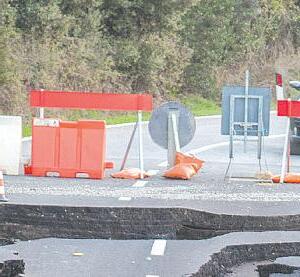
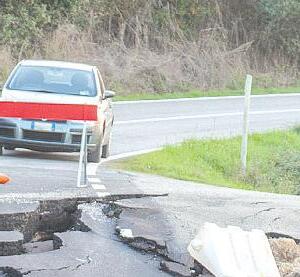
The shaking is your t
X A tsunami is a series of waves. The first wave to arrive is often not the largest, and each wave may be separated by up to an hour or more. Waves may continue for many hours – stay away from the shore until local government officials tell you it is safe to return.
IF YOU ARE NEAR THE OCEAN DURING AN EARTHQUAKE:
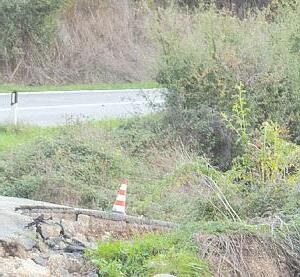
■ DO move to higher ground once the shaking stops.
Tsunami waves may arrive for hours Protect yourself during earthquakes

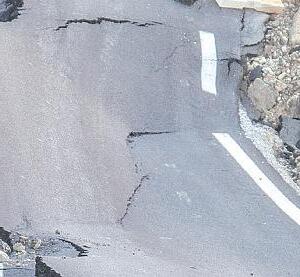
in the Capital Region Tsunami waves may arrive for
■ DO monitor local media.
■ DO follow the instructions of authorities.
■ DO NOT go near the water to watch.
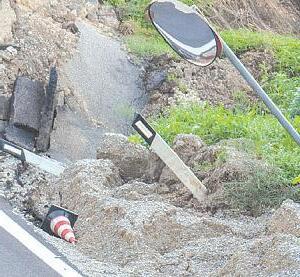
The shaking is your t sunami warning in the Capital Region
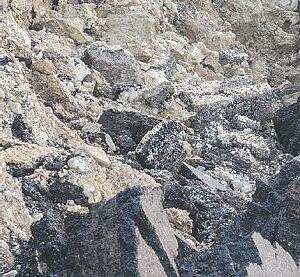
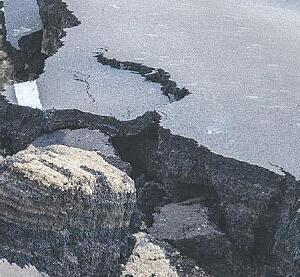

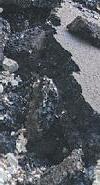
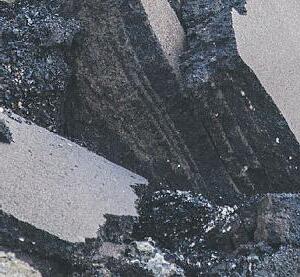

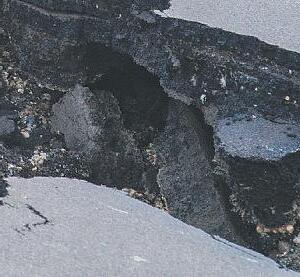
Section 1: BEFORE
DO Drop, Cover and Hold On until the shaking has stopped
DO move to higher ground
A tsunami is a series of waves. The first wave to arrive is often not the largest, and each wave may be separated by up to an hour or more. Waves may continue for many hours — stay away from the shore until local government officials tell you it is safe to return.
X DO NOT call 911 unless you have a life-threatening emergency and stay off phone lines as they will be in use by emergency personnel.
DO stay tuned to local media for updates
DO follow the instructions of authorities
DO NOT go near the water to watch
X Stay tuned to local media for further instructions. (Have a battery-powered or wind-up radio in your grab & go bag and know your local radio, TV and trusted social media sources of information.)
■ DO NOT call 911 unless you have a life-threatening emergency and stay off phone lines as they will be in use by emergency personnel.
Tsunami signs to watch for at the beach: A sudden rise or fall of ocean level
■ Stay tuned to local media for further instructions. (Have a battery-powered or wind-up radio in your grab & go bag).
A loud roaring noise coming from the ocean
Ground shaking
In the event of a tsunami warning, local governments will communicate instructions using various methods. These may include telephone/email/text alert systems, sirens, social media channels, websites or door-to-door visits. Check www.PrepareYourself.ca to find out which systems your local government uses, and if there is an alert system you can subscribe to.
■ It is important to remember that the waves will continue to arrive for many hours after the initial rise and fall of the ocean level.
■ In the event of a tsunami warning, local governments will communicate instructions using various methods. These may include telephone/email/ text alert systems, sirens, social media channels, websites or door-to-door visits. Check PrepareYourself.ca to find out which systems your local government uses, and if there is an alert system you can subscribe to.
■ DO NOT go back to tsunami hazard areas until instructed by local government officials.
It is important to remember that tsunami waves will continue to arrive for hours after the initial rise and fall of the ocean level.
It is important to remember that the waves will continue to arrive for many hours after the initial rise and fall of the ocean level. DO NOT go back to tsunami hazard areas until instructed by local government officials.

The most important thing to remember during an earthquake:
X DROP to the ground (before the earthquake drops you!),
■ DROP to the ground (before the earthquake drops you!),
■ Take COVER by getting under a sturdy desk or table (or against a wall with your arms covering your head/neck), and
X Take COVER by getting under a sturdy desk or table (or against a wall with your arms covering your head/neck), and
■ HOLD ON to your shelter and be prepared to move with it until the shaking stops.
X HOLD ON to your shelter and be prepared to move with it until the shaking stops.
These three steps are the best way to reduce injury and death during an earthquake.
These three steps are the best way to reduce injury and death during an earthquake.
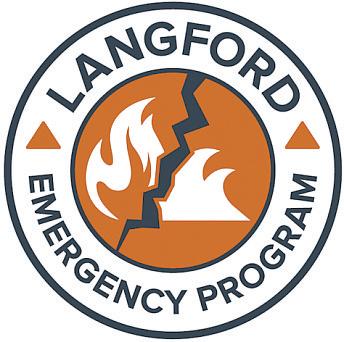
The Langford Emergency Program would like to congratulate and thank Langford’s ESS dedicated volunteers in recognition of Emergency Preparedness Week.

Emergency Program
In Recognition of Emergency Preparedness Week, we would like to acknowledge all the hardworking PEMO Volunteers. We value your dedication and commitment to enhancing community safety.
Thank you for your service!

Contact:
250 544 4231 emergencyprogram@csaanich.ca
We appreciate and thank the Saanich Emergency Program volunteers for their dedication to our community. Your commitment, knowledge and enthusiasm make a positive difference every day.
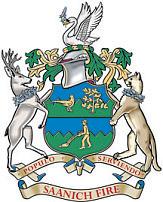
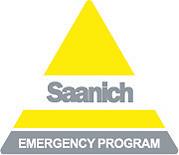
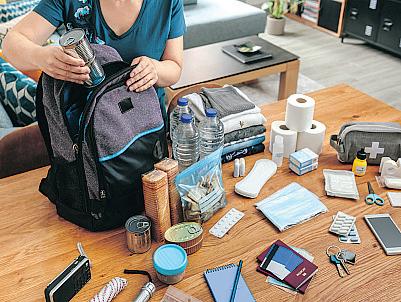



@SaanichEP @SaanichFire

The Colwood Emergency Program would like to recognize and thank our dedicated Emergency Program Volunteers for their time, energy, and commitment to keeping our community safe.
colwood.ca
@cityofcolwood westshorealert.ca 250-478-8321
We would like to acknowledge and thank our Emergency program volunteers from our ESS and Emergency Radio Communications teams.
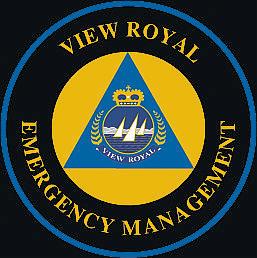

The Sidney Emergency Program extends its sincerest appreciation to our volunteers who continue to exceed expectations and provide exceptional service.
Thank you!
@SidneyFireDept

The Nor th Saanich Fire Depar tment would like to thank all of our dedicated volunteers for their time, effor t and commitment to keeping our community safe.
250-656-1931 NorthSaanichFire.ca

This Emergency Preparedness week, the Port Renfrew Volunteer Fire Department wishes to express its sincere appreciation for the dedication demonstrated by all of our First Responders, Paramedics and ESS Volunteers, in service to our community.

You and your family should be prepared to be selfsufficient for at least seven days after an emergency. This section will provide you with the resources to be ready and equipped for all emergencies, including how to create an emergency plan to reunite with your family, how to secure heavy items in your home, and how to build emergency kits and grab & go bags. Once you’re prepared, you will learn about the hazards in the capital region and specific considerations for each of those hazards.
Recommendations:
EMERGENCY PLAN
1 Ask an out-of-area friend or relative to act as a contact for family members who may become separated during a disaster.
2 Decide in advance, as a family, where to meet and where to shelter in case you are separated and/or are unable to remain in your home in a disaster.
3 Make copies of important photos and documents and store them offsite, online or on a password-protected USB drive.
4 Connect with your neighbours and discuss how you can work together to help each other during emergencies.
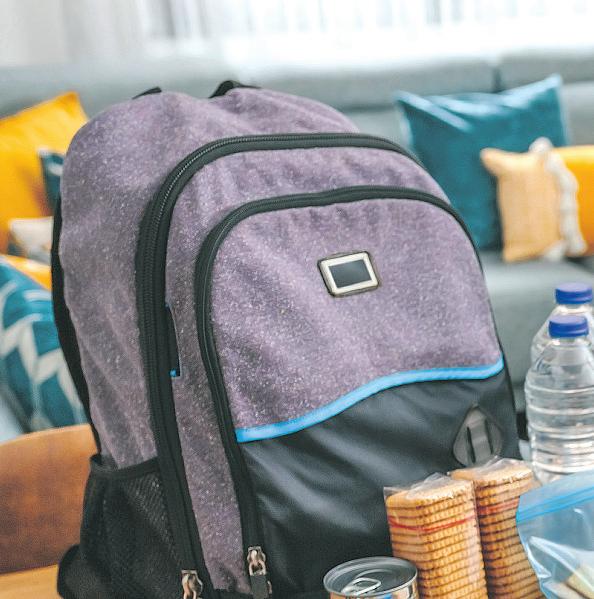
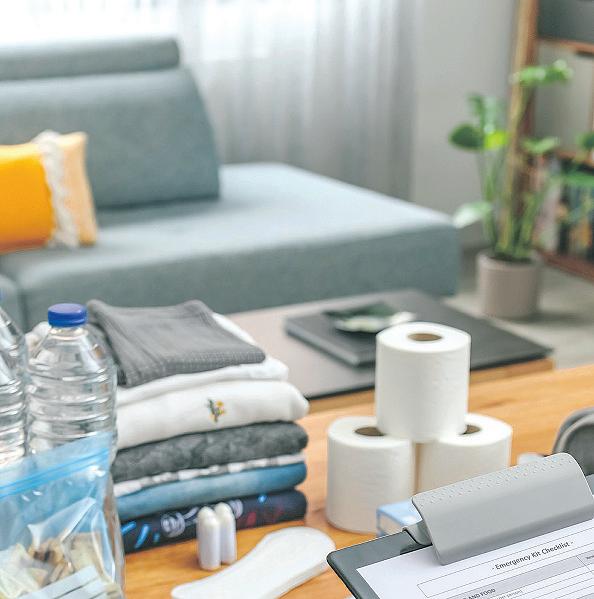

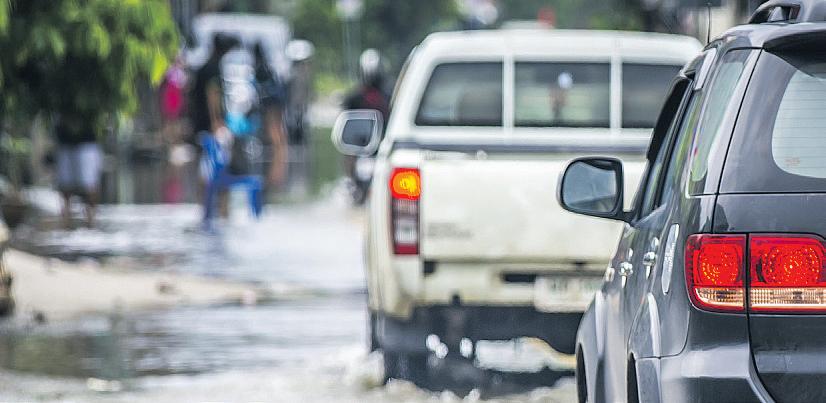



An emergency plan will help guide you and your family in case of an emergency. The plan should include:
■ Places to stay in case you cannot access your home, such as a friend or relative’s house, RV, boat or hotel.
■ Two routes, that everyone knows, to the reunification spot from where they live, work and play.
■ How you will communicate in case you and your family members are separated.
■ Contact people both in your local area and out-of-area.


One of the most important things you can do is to plan how you will connect with your family in case of an emergency.
An emergency can strike at any time, maybe while you are at home, work, school, driving or pursuing

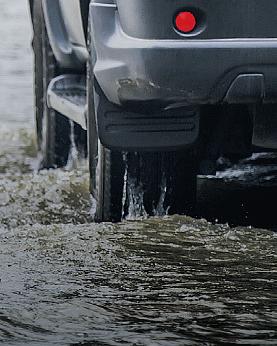
hobbies. It is important to know where each family member will be, how you will communicate with each other and to have a reunification spot identified ahead of time. It is also important to know how to contact trusted information services.
■ Safe exit routes from your home and work.
■ Risks in the region.
■ Locations and proper use of important equipment such as fire extinguishers, gas and water valves, floor drain(s) and the electrical box.
■ Those who may rely on you for assistance: children, family members with special considerations, and pets.
■ Arrangement for care and evacuation of pets and farm animals, especially if you are away when disaster strikes.
■ Health information, such as allergies, necessary medication, equipment and contact details for doctor, pharmacy, and other important health providers.
■ A list of important contacts, vital documents, and small valuables to take with you if you are evacuated.
■ Insurance policies and photo or video documentation of home contents.

After a disaster, it’s best to remain in your own home if you can do so safely. You will need supplies for cooking, making temporary repairs and providing comfort for your family. The emergency supplies should be kept separate from the things you normally use, to ensure they are available and in working order.
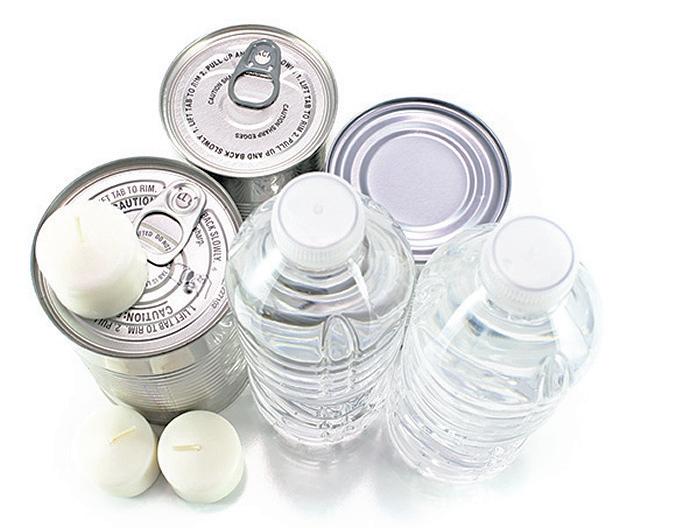
■ Potable (drinkable) water: 4 litres per person per day for at least 7 days, plus water for pets.
■ Food, emergency stove and cooking equipment: a variety of long-storing healthy foods that do not need refrigeration and are easy to prepare and eat under difficult conditions, such as nutritious canned food.
■ Health and safety: home first aid kit and first aid manual; power failure lights for halls/stairwells; fire extinguishers.
■ Communications: a landline phone that operates on a phone jack and does not require electrical power (corded phone) or an emergency radio (battery- or solar-powered, or wind-up).
■ Heat, light and warmth: sleeping bags (much warmer than regular bedding, Mylar blankets, ground sheets or air mattresses, newspaper (for insulation); camping tent or tarpaulin and ropes (in case house is unsafe and there are no other alternatives); flashlights with lots of batteries, light sticks, battery-powered or solar lanterns.
■ 2 bottles of water
■ simple food (e.g. unsalted nuts, granola bars)
■ small first aid kit
■ walking shoes
■ road map and compass
■ shovel, traction aids (kitty litter or sand)
■ flashlight (extra batteries)
■ sweat pants and zipper hoody
■ light sleeping bag
■ Sanitation and hand-washing: duct tape, lots of plastic garbage bags, emergency toilet kit, disposable gloves, outside garbage can for disposal of waste bags, toilet paper, baby wipes, liquid soap, alcohol-based hand sanitizer, potable water and paper towels.
■ Rescue, repair and clean up: tarpaulins, nylon ropes, duct tape, plastic sheeting and/or large garbage bags; axe, crowbar, hacksaw; aluminum shut-off wrench for gas meter; head lamp, work gloves, dust masks, coveralls, sturdy shoes, goggles, rags, non-permeable disposable gloves, clean utility water (non drinkable), detergents, and large, clear plastic garbage bags for taping over broken windows.
■ Household generator and fuel: especially for needs such as refrigerated medication, medical appliances and equipment, etc. Generators must never be operated in the house or other enclosed space. Generators may be a target for theft if left unattended.

YOU MAY WISH TO INCLUDE THE FOLLOWING:
■ toilet tissue and Ziploc bags
■ deck of cards, book
■ duct tape and garbage bags
■ work gloves
■ axe, crowbar and fire extinguisher
■ flares, reflective vest(s)
■ hard hat, eye goggles and coveralls
■ ice scraper and brush
■ jump starter and power bank (Eliminator®)






■ two small bottles of water, two energy bars, chewing gum
■ one week’s worth of prescription medication and copy of prescriptions
■ extra pair of eye glasses, batteries for hearing aids, etc.
■ emergency blanket (Mylar “space blanket“)
■ emergency rain poncho or large plastic garbage bag
■ whistle and dust mask (earthquakes can stir up thick clouds of dust)
■ emergency radio/flashlight with extra batteries
■ multi-tool/Swiss Army knife
■ mini first aid kit – items such as pain tablets, eye drops, ointment, nitrile gloves, foil pack of water, etc.
■ photocopies or password-protected USB drive of important wallet contents and insurance policies
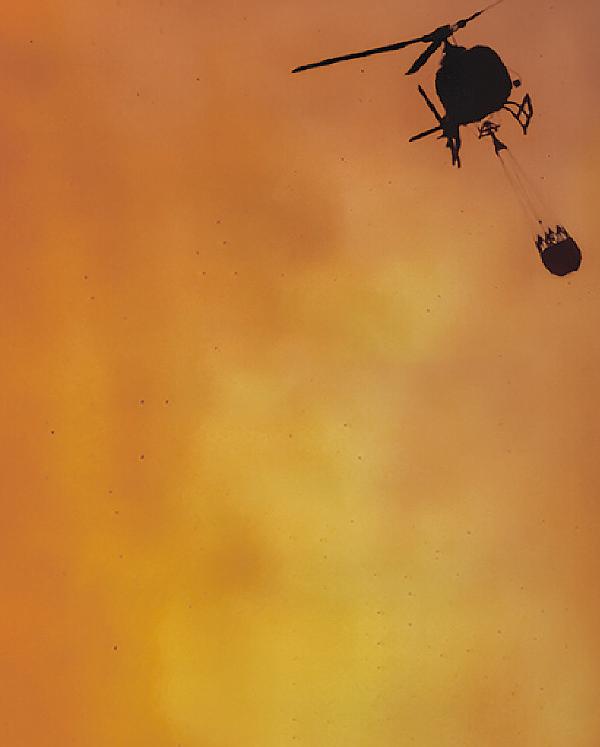
■ key contacts list, cellphone and phone card
■ notebook and pen or retractable pencil
■ supply of cash in small bills and coins
■ spare keys for home, car, other
■ recent photos of family and pets
■ book, cards, puzzles
■ chargers and adaptors for cellphones and other electronics included in your grab & go bags




If you spend a lot of time in your car, boat or RV, you should have an emergency kit to supplement your grab & go bag. Regularly maintain your vehicles and keep the fuel tanks at least half full so you’re ready to leave in a hurry. Even if you do not have to evacuate, your car can be a place to shelter, recharge your cell phone, warm up or listen to radio reports.

■ Plastic water bottles will absorb vehicle fuel vapours, so foil packs are a good option for mobile kits, or place plastic water bottles in a sealed plastic container.
■ A plastic storage bucket for car/mobile supplies can be converted to a toilet if needed. Small, portable toilet seats can be purchased for some types of buckets.

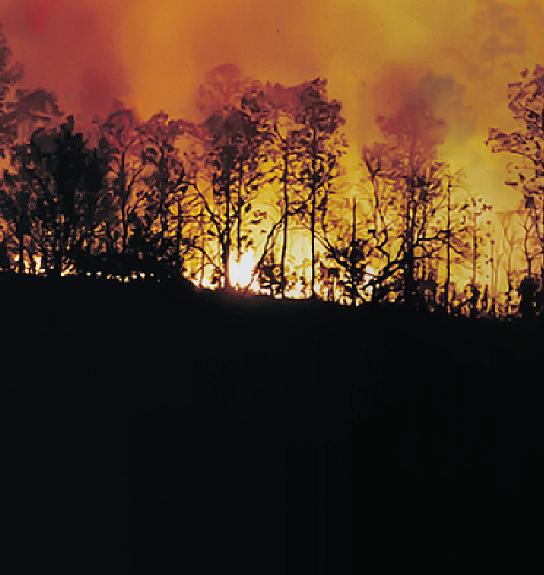

You may have special considerations during an emergency, such as vision, hearing, mobility, speech, language or understanding limitations. Your plan should include the things you may need to shelter in your home or away from your home
■ Develop a “buddy” system with family, friends and neighbours to check on each other after an emergency. Telephones may not be working, so arrange check-ins with people who live near you. You may want to give your “buddy” a key to your home.
■ Keep a list of medications, allergies and special equipment. Include the name, address and telephone numbers of important contacts like your doctor, pharmacist, family members, clergy or friends. Provide a copy to each “buddy” and keep a copy with you at all times.
■ Remove or properly secure hazards in the home that could fall or cause injury.
■ Develop a backup plan for life-sustaining equipment so it works in the event of a power outage, which may include buying an emergency generator. Ensure you know how to properly operate and fuel your equipment.
■ If you use oxygen, ensure the tank is secure.
GENERAL INFORMATION
■ If you use a wheelchair or walking aids, keep them near you at all times and have extra walking aids in other areas of the house.
■ Place a battery-powered night light or flashlight in each room.
■ Keep a whistle or horn handy to signal for help.
■ If you use battery-powered equipment, ensure you have extra batteries properly stored and accessible.
■ If you require continued service from a service provider during an emergency, make a list of all the required contact and service information and put it with your important papers. Ask each service provider for a summary of their emergency plans so you know what to expect following an emergency or disaster.
■ BC Emergency Health Services (formerly BC Ambulance) – bcehs.ca
■ BC Centre for Disease Control – bccdc.ca
■ BC Hydro Outages – bchydro.com/outages
■ BC Ministry of Health – gov.bc.ca/health
■ BC RCMP – bc.rcmp–grc.gc.ca
■ BC Wildfire Service – bcwildfire.ca
■ Disability Alliance BC – disabilityalliancebc.org
■ Drive BC – drivebc.ca
■ Emergency Info BC – emergencyinfobc.gov.bc.ca
■ Emergency Management BC – gov.bc.ca/PrepareBC
■ Emergency Preparedness in the Capital Region – PrepareYourself.ca
■ Emergency Social Services BC – 2.gov.bc.ca/gov/content/safety/emergencypreparednessresponse-recovery/volunteers/emergency-social-services
■ Environment Canada weather – weather.gc.ca
■ Fortis BC – fortisbc.com
■ Island Health – viha.ca
■ Ministry of Environment – gov.bc.ca/env
■ National Tsunami Warning Centre – tsunami.gov
■ Natural Resources Canada – nrcan.gc.ca
■ Public Safety Canada – getprepared.gc.ca
■ ShakeOutBC – ShakeOutBC.ca
■ University of Victoria Weather Network – victoriaweather.ca
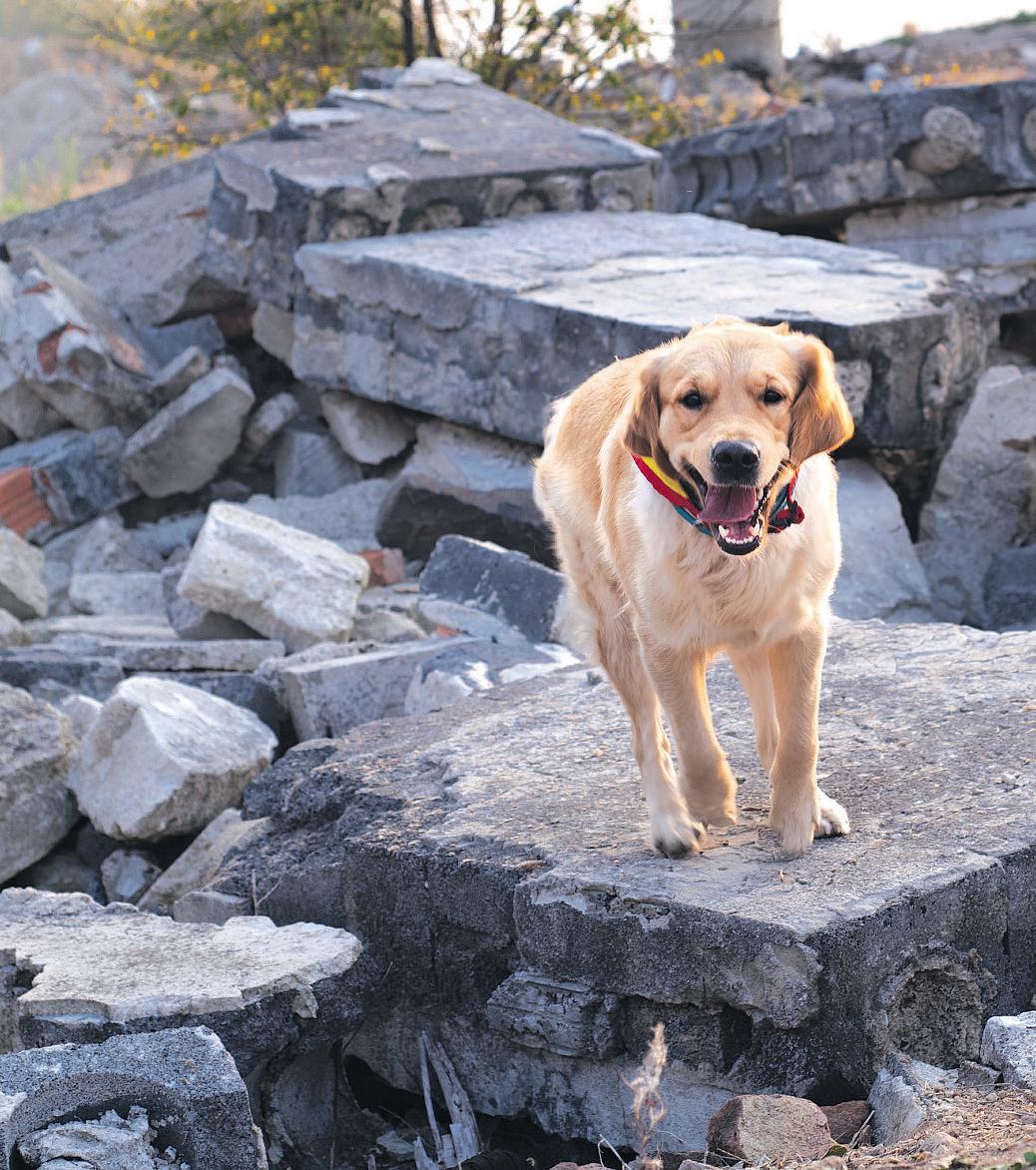

Plans for pets can save precious time and maybe even your pet’s life. Make sure you designate someone to care for or evacuate your pet if you are not home when disaster strikes. If you have to leave your home, you will have to decide whether to take your pet with you. Keep in mind if you are evacuated to a group lodging facility or reception centre, you may need to make alternative arrangements for your pets.
IF YOU CHOOSE TO LEAVE YOUR PET AT HOME:
■ Make sure they have dry food and water for at least seven days.
■ Put them in a room where there is access to a high counter in case of flooding and that is free of hazards such as windows, large mirrors or picture frames.
■ Separate your dogs, cats and other smaller pets as they may behave differently under stress.
■ Leave a sign on your door with the number of animals in the house along with their locations so emergency responders know where to look.
IF YOU CHOOSE TO TAKE YOUR PET WITH YOU:
■ Put them in a sturdy portable carrier and make sure they are comfortable with it beforehand.
■ Include items for your pet in your emergency kit, such as dry food, water and medications.
FARM ANIMALS
Farm animals include alpacas, cattle, donkeys, fur-farmed animals, goats, horses, llamas, mules, poultry, rabbits, sheep and swine.
Make sure you have an evacuation plan in place and that you designate someone to execute the plan in case you are away when an emergency happens.
Construction to begin this summer in Langford on a new CREST public safety building for the Capital Region.
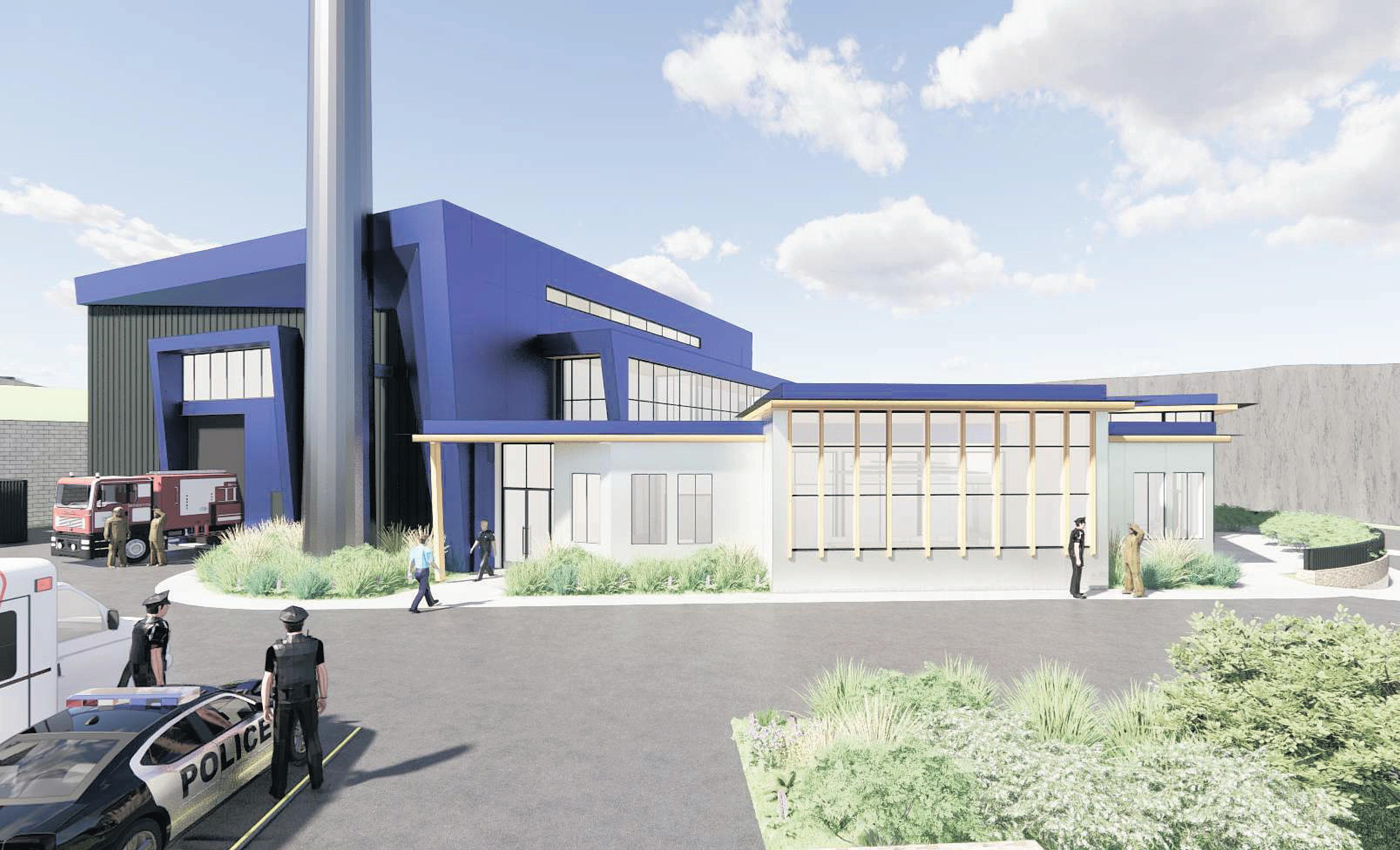
When the Capital Region’s first responders and public service agency personnel head out to work each day, they are connected to one another 24/7, 365 days a year by a emergency telecommunications network operated and maintained by the Capital Region Emergency Service Telecommunications Inc. (CREST). In 2020, CREST completed a region-wide upgrade to an all digital P25 platform considered a world standard in public safety communications. This investment significantly improved audio clarity for all users and introduced life-
safety features of interoperability and encryption. To keep pace with population growth, thirtyfive transmission towers and more than seventy-five in-vehicle repeaters have been added throughout the region to improve and increase coverage, and colocation agreements with Rogers Communications have enabled CREST to extend their network along Highway 14 from Shirley to Port Renfrew, as well as on the Gulf Islands.
Being prepared for a largescale emergency is important for everyone. It’s essential
for CREST. The CREST network allows for critical public safety resiliency and provides the region’s first responders with the best communications tools available.
Ensuring that CREST’s operations, infrastructure and equipment are housed in one location in a postseismic building is the next step.
Site preparation for a new CREST public safety building is underway at 2321 City Gate Boulevard.
“It’s critical that our region’s public safety technology and infrastructure is protected and remains intact and operational every day, especially in times of
greatest need,” said Esquimalt Councillor Tim Morrison, who chairs the CREST board of directors. “Having a purpose-built, post-disaster building for CREST is an emergency management best practise. It sends a strong message of confidence to our region’s first responders and the public that CREST is prepared and will be there in the event of a large-scale disaster.”
Langford Fire Rescue Chief Chris Aubrey agrees. “Ensuring first responder agencies and personnel can deliver lifesafety services during a major
emergency is essential. To that end, CREST is the foundation of our success. This project will benefit the region and its residents for many years to come.”
More than fifty emergency response and public service agencies rely on the CREST network to keep themselves and the public safe. In 2023, the CREST network handled more than 10-million individual transmissions (one transmission every three seconds). crest.ca

The capital region is made up of 13 municipalities and three electoral areas. Each is responsible for its own local emergency program. These emergency programs help support and manage the planning, preparedness and response efforts in your community. You can contact your local program to:
■ Obtain information on emergency preparedness and upcoming workshops and events,
■ Arrange an emergency preparedness workshop for your organization or community group, and
■ Volunteer for local neighbourhood programs such as Emergency Social Services (ESS), Search and Rescue (SAR) and Emergency Radio Communications (Comms).
Keep these local & national emergency numbers handy! For more info: prepareyourself.ca
Central Saanich centralsaanich.ca
Colwood colwood.ca
Esquimalt esquimalt.ca
Highlands highlands.ca
Langford cityoflangford.ca
Metchosin metchosinemergencyprogram.ca
North Saanich northsaanich.ca
Oak Bay oakbay.ca
Saanich saanich.ca
Salt Spring Island crd.bc.ca
Sidney sidney.ca
Sooke sooke.ca
Southern Gulf Islands crd.bc.ca
Victoria victoriaready.ca
PrepareCRD @PrepareCRD
Central Saanich @CSaanichFire
Colwood @cityofcolwood
Esquimalt @EsquimaltBC
Highlands @HighlandsEP
Juan de Fuca @JdFemerg
250.544.4238 emergencyprogram@csaanich.ca
250.478.5999 emergencyprogram@colwood.ca
250.414.7120 emergency.program@esquimalt.ca
250.474.1773 lhilton@highlands.ca
250.478.9555 firechief@cityoflangford.ca
250.478.1307 firechief@metchosinfire.ca
250.656.1931 emergprogram@northsaanich.ca
250.592.9121 obep@oakbay.ca
250.475.7140 sep@saanich.ca
250.537.1220 ssiepc@crd.bc.ca
250.656.2121 firedept@sidney.ca
250.642.5422 info@sooke.ca
866.308.6160 sgiepc@crd.bc.ca
250.920.3373 emvic@victoria.ca
250.479.7322 emergencyprogram@viewroyal.ca
Langford @LangfordFire
Metchosin @MetchosinEOC
North Saanich @dns_fire
Oak Bay @OakBayFireDept
Saanich @SaanichEP
SGI @SGIEmergPrg
Sidney @SidneyVFire
Sooke @Sookeca
SSI @SSIEmergency
Victoria @CityOfVictoria
View Royal @VRFD
Cowichan Valley Regional District
Juan de Fuca Electoral Area
■ Do not call 911 unless life-threatening emergency.
■ Emergency officials will rely partly on local media and the Internet to get information to the public.
Cable TV, radio and the Internet are some of the tools that officials will use to help communicate evacuation alerts and bulletins about impending dangers such as severe storms, wildfires and tsunami.
■ After a disaster, officials will provide updates via the media as facts and information are confirmed.
Check PrepareYourself.ca or your local authorities websites for updates.
■ Most local media (TV and radio) do not have staff on duty 24/7; therefore, if a disaster occurs during the night, only the stations with staff on duty will be able to broadcast during the first few hours of the disaster. Other stations might bring in staff to provide 24/7 news during the disaster, but that could take hours or days.
■ During a disaster, tune in to local media for news updates via your emergency radio. If you are online, join the conversation on Twitter for regional emergency information from @PrepareCRD and EMBC’s emergency feed @EmergencyInfoBC for provincial information.
■ There will be lots of rumour, opinion and speculation, especially on the Internet. When making decisions for yourself and your family, rely on news that clearly comes from trusted official sources such as local government officials, first responders, utilities and Environment Canada.
■ Become familiar with your local broadcasters, and check periodically which stations have 24/7 live broadcasts. In Greater Victoria, local media include:
•
• Local TV Stations

Please contact your representative today!